
46 minute read
INTERVIEWING
Storytelling: Part 2
In our last column, we introduced the idea and importance of using a story to expand on empathy and show understanding, as well as the structure of telling a good story. In this column, we will address how the story works and why it continues rapport and builds trust.
The stories that we choose are not about the individual to whom we are speaking, but rather others who have faced circumstances or problems that are common to everyone. When using stories to show understanding and empathy, the interviewer does not have to talk about circumstances that are illegal or immoral when developing the stories. In fact, the discussion seems to be much more effective when it doesn’t deal with these types of issues but instead focuses on more everyday circumstances that people face. The stories that are most effective are those that fit the experience of the listener’s everyday life. When focusing on common stories, it allows the individual to more easily generalize the information into their own decision-making.
Types of Stories
Stories can provide a means of encouraging action, letting the listener visualize how to change their circumstances. The story cannot have so much detail that it engages all the cognitive ability of the listener; it must leave enough resources so that they can consider their own personal changes.
Some stories may be used to share knowledge with the listener about how problems got resolved or failed to do so. The story can focus on a myriad of possible options to resolve the problem or leave it unfulfilled. This type of story by David E. Zulawski, CFI, CFE and Shane G. Sturman, CFI, CPP
Zulawski and Sturman are executives in the investigative and training firm of Wicklander-Zulawski & Associates (w-z.com). Zulawski is a senior partner, and Sturman is president. Sturman is also a member of ASIS International’s Retail Loss Prevention Council. They can be reached at 800-222-7789 or via email at dzulawski@w-z.com and ssturman@w-z.com. © 2020 Wicklander-Zulawski & Associates, Inc.
can use social proof of how others have handled problems or failed to do so while providing an opportunity to consider available options.
Other stories can focus on the future and the opportunities that lie ahead. This allows the listener to begin to become comfortable with what the future may hold. Listening to how others have handled obstacles gives people an opportunity to visualize the variety of avenues the future may hold for them.
So the stories can offer insight and resolution, but more importantly they commit the listener and create a state of engagement and thinking. Each story is presented as something of value worth listening to and should actively reflect the truth. Our truth is that we believe it’s good to talk through problems. When people are engaged and thinking about the story, they begin to apply the circumstances to their own situations and consider the possible remedies.
What’s in It for Me?
One thing that the interviewer should consider is the mindset of the subject. If I do this or that, “What’s in it for me?” Many decisions are simply made by considering the personal benefits of a course of action. If the positives outweigh the negatives, then the choice is easily made. If the negatives outweigh the positives, the choice is also easily made. When there is a balance between the two, however, it is often a story that can help change the balance.
Stories to Encourage Action
The subject must see something worthwhile achieved in the story. For us in showing understanding, our story revolves around a change of perspective. When people are in trouble, they position themselves as victims who are helpless. The purpose of this story is to reengage the individual, providing an opportunity for them to have some power in the situation. To do this, we might select a story that puts them in a decision-making capacity over others. They are now in a position where they must evaluate the actions and explanations of others and then decide. Intellectually this takes them out of the role of victim, and they now must consider how other people acted in a difficult situation.
In this simple story, one of the people in trouble decides to deny his action while the other explained what happened and how he made his decision. In the story, as the decision-maker, the subject will appreciate the cooperation and discussion the second person decided to use. This is a decision the subject makes by themselves unaided, and they have now committed to a course of action that they believe is appropriate. The subject has identified their own benefit in the story, one that can be applied to their situation. Their commitment to this course of action encourages consistency with their decision, which has already been made.
Focusing on the Future
For the people whom we deal with, our conversations with them occur at a particularly dark moment in their lives. This moment is filled with fear about the unknown, and their primary concern is the present rather than their future. They are concerned about their fears: arrest, termination, embarrassment, financial problems, or some other issue. The purpose of the story focusing on the future is to illustrate better days and outcomes. Effectively, this story revolves around a rags-to-riches concept or adversity overcome. This does not mean financially necessarily but moving from a point of despair to hope or making lemonade out of lemons.
There are literally thousands of stories of people who overcome the odds to recover or exceed what they had done before. Consider the story of Mike Lindell.
The Story of Mike Lindell
People have a choice of how they want to deal with their difficulties. Some just go with the flow being pushed one way or another, while others step up and look toward a different future.
I remember an incredibly interesting story about a guy named Mike. Mike was fired from one of his first jobs at a grocery store after a disagreement with the manager. He went on to fail at a carpet-cleaning business, as a card counter in Las Vegas, as a pig farmer, and in a lunch-wagon business. He finally purchased a bar and became addicted to crack cocaine. His life was literally one disaster after the next.
Mike was having trouble sleeping because his pillow wouldn’t hold its shape. He learned to sew, so he could make a prototype pillow that would hold that shape. While he had a bit of success selling a few pillows, the cocaine slowly took a grip on his life, causing him to lose his wife, his house, and almost his business. He hit bottom, and even his cocaine dealer cut him off because he was using too much crack. He was down and out. Then he got control of his addiction and his business.
At that point he was selling maybe $100,000 worth of pillows. He got his act together, focused on a better tomorrow, and today he employs over 1,500 people and has in excess of $300 million in sales. Just think: today 1,500 people are gainfully employed, just by Mike, not to mention those that are employed by his suppliers because he looked forward to better days.
He came to that crossroads in his life where he had to make a decision about which way to go. We’ve all been at that place at one time or another. That’s why it’s always important to think about the future and where we want to be.
Common Ground
The stories that we tell the subject focus on understanding the individual circumstances and decision-making that brought the person to that crossroads. Often, a story is chosen to convey a message that would be difficult to say directly, but the shared experiences of life allow the message to be conveyed to the subject. Sometimes the story names the problem, so the subject can more clearly assess how it affects their life and situation. Ironically, the stories also effect the teller using the same parts of the brain that the listener uses when considering and evaluating the story. This builds empathy and a common bond between the teller and the listener as they both experience the effect of the story. Both are relating to a situation they could see themselves in.
Regardless which type of story the investigator tells, there is a flow or sequence of events that connect with one another. There is some form of conflict that keeps the listener’s interest to find out how it ends. There is fear and dread about what is going to happen. This is where the subject is mentally and emotionally. The finality of the story relieves the pressure, making the individual feel better. And finally, there is the moral of the story, which leaves no question about what was to be understood.
The investigator uses stories to build a connection with the subject, showing understanding, sharing empathy, and building rapport. Our stories and the reactions to them give the listener an opportunity to show agreement, neutrality, or disagreement with its premise. Just as importantly, it gives the listener an opportunity to assess the teller’s character, understanding, and empathy toward others. If the listener hears this and assesses it in a positive fashion, it builds trust and encourages the view that we are not so different after all.
PROTESTS AND PROPERTY PROTECTION LP STRATEGIES FOR TODAY’S SYSTEMIC THREAT OF SOCIAL UNREST
As the image spread of George Floyd going lifeless under the knee of a Minneapolis police officer, it was with bitter wisdom that LP professionals could see where this was heading.
“The reality is that every police officer trial, every police shooting, has become a potential flashpoint,” said Dave Colen, former director of corporate investigations and standards at Walgreens. And that was back when stores were burned and windows smashed after Freddie Grey died in the hands of Baltimore police. Five years on, the risk to retailers has only grown from social unrest, ideological and political protests turning violent, and associated criminal opportunism.
Chaos causes survival instincts to kick in. It fuels a need to protect oneself. And that is certainly one important element of readying for protests and mitigating the impact from vandalism and looting. Merchants learned—or relearned—about threats, vulnerabilities, and physically protecting individual stores.
But the scope of this summer’s looting, the scale of wanton destruction, and the remedies that cities subsequently discussed were also reminders of just how connected store security is to the larger retail ecosystem and to society at large—and of the work still to be done on many levels to build resilience. It’s a lesson for loss prevention that top retail executives have warmed to as many were uncharacteristically vocal in expressions of solidarity with peaceful calls for racial justice and police reform. Store security, like a retail brand’s fortunes, is captive to large external forces.
The spark lit in Minneapolis surely evoked a sense of déjà vu, but the stage was uniquely set for the fire to burn hotter. Months of social isolation, crushing unemployment, organized retail crime (ORC) gangs looking to make up for missed opportunities during shutdown orders, escalating societal divisiveness, rancor, and incivility—it all bore down squarely on retailers in late May. “At the very moment when retail establishments were restocking shelves in anticipation of the lifting of COVID-19 restrictions, the riots in major cities added another layer of risk to their businesses,” explained Timothy Williams, vice chairman with Pinkerton and a security and risk mitigation expert.
For more than a week, stores burned and were ransacked. A Target in downtown Minneapolis was among the first and hardest hit, and hundreds of Timothy Williams other stores were destroyed. Soon, violence and destruction became frighteningly widespread. Entire streets worth of shops burned to the ground. Nordstrom’s flagship in Seattle and Neiman’s in Dallas were vandalized. Apple, Verizon, and myriad other electronic stores were ransacked in major cities across the country. High-end sneaker and cannabis shops were targets of choice. Chanel and other luxury stores in Manhattan and in exclusive shopping districts nationwide were picked through. More than $1 million worth of products was stripped from a Louis Vuitton store in Atlanta. Cities said they were calculating losses in billions.
Major retailers of all stripes closed up shop in affected areas. More than 250 CVS stores across twenty-one states were damaged, and sixty remained closed more than a week
How Organizations Use Information Posted on Social Media* to Manage Crises
77% 42% 40% 39% 39% 38% 37% 36% 33% 30% 22% 20% 9%
Understand the scope and magnitude of the crisis
Learn how others perceive our company’s actions and response
Update our corporate communications
Reposition people and assets out of harm’s way
Update the executive team
Support our internal investigations
Improve employee travel risk management
Comply with state, local, or federal emergency directives
Justify changes in security protocols and procedures
Monitor the safety and integrity of our supply chain
Ensure business continuity
Justify maintaining or increasing our executive protection program
We don’t use social media alerts to manage the crisis
*or other online platforms Source: 678 responses to a joint survey by Dataminr and Security Management magazine of members of ASIS International, Oct. 2018.
after protests started, according to the company. A Target spokesman said 200 stores were closed the weekend following the killing of George Floyd, and several remained closed until they could be repaired after sustaining major damage.
Retailers have contended with protests-gone-wild many times before. Damage and looting of retail properties associated with civil unrest is nothing new. But there did seem to be something different this summer, and it could change how retail will need to assess risks from protests and social movements moving forward.
The riots revealed the ability for today’s social unrest to spread rapidly, “enabled by uncontrollable social media and new democratized communication” that can quickly “bring thousands of people together in coordinated protests,” according to the Cambridge Centre for Risk Studies, which has conducted “stress case scenarios” of social unrest to understand how they might spread and the damage they’re likely to cause. “Social unrest is now a systemic threat [and] has the potential to manifest in large-scale simultaneous occurrences,” the Cambridge Centre warned. “It poses a serious and growing societal threat” that “is changing the way that businesses are thinking about their risk from political instability.”
Several retailers told LP Magazine that civil unrest and social protests have raised the bar for retail crisis preparedness programs. Additive to traditional sources of agitation, LP teams now must track every police officer shooting, impending verdict, and key anniversary date to analyze the potential for it to spark protest and put store assets at risk. The senior asset protection manager for a national retailer said their crisis team convenes an emergency call whenever an event occurs that could spark a violent community response. “As unrest grows, it can potentially bring violence, looting, and property damage,” warned Alex Hearding, chief risk management officer at the National Cannabis Risk Management Association. He saw devastation firsthand this summer, noting that many member businesses were completely cleaned out in major cities across the country. Alex Hearding
It is also hard to imagine that this summer’s social unrest was a one-off. Racism sparked this summer’s unrest in the US, but a combination of unemployment, tribal politics, and unequal wealth distribution could drive sociopolitical unrest in many parts of the world. Anger recedes, tempers cool, redress may even placate protestors for a time, but the risk of violence to stores remains ever present, dormant until the next viral video, election result, or catalytic event. What issues might LP think about during the during the respite?
An Evolving Risk Picture
As events unfolded, before the benefit of hindsight, many motives seemed to be fueling the looting and property destruction associated with protests after George Floyd’s killing. The primary driver was a subject of much debate, often falling along political lines. To some, Antifa was sparking most of the violence. Others pointed fingers at white nationalists intent on discrediting peaceful protestors. State and local officials facilitated the narrative by claiming
The spark lit in Minneapolis surely evoked a sense of déjà vu, but the stage was uniquely set for the fire to burn hotter. Months of social isolation, crushing unemployment, organized retail crime (ORC) gangs looking to make up for missed opportunities during shutdown orders, escalating societal divisiveness, rancor, and incivility—it all bore down squarely on retailers in late May.
violence was provoked by “outsiders”
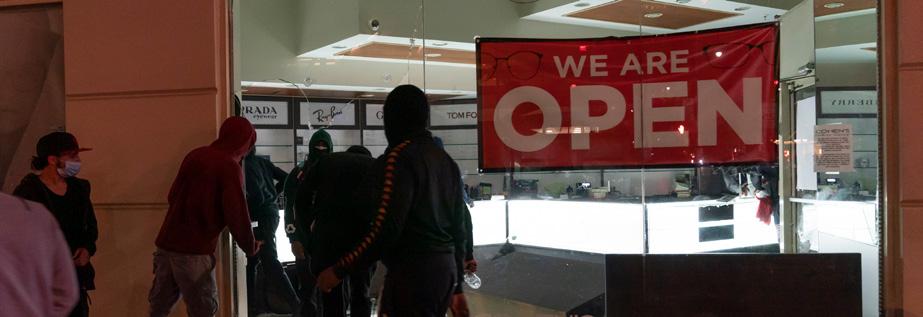
rather than placing responsibility on members of their own communities.
The Loss Prevention Research Council (LPRC) brought together members to share intelligence and solutions amid the turmoil. In a situation analysis summary from an emergency group call, which included participants from twenty retailers and topical experts, several groups were identified for co-opting the protests. They included far-left groups seeking to promote revolution and far-right groups attempting to stoke racial divisions and instigate a “race war.” But the call summary noted that the social unrest was co-opted by another
force: individuals engaging in crime for personal gain.
This simpler reality seemed a more common culprit to some. Yes, anger was boiling over, and some protesters may have reacted violently to police shows of force or been goaded by the media’s looting-heavy coverage, but much of the store theft was likely unprincipled, committed for self-gain. It’s even what Joe Biggs, an organizer for the ultra-right hate group Proud Boys, told journalists he thought was behind the looting. “What they really want is a new 72-inch screen TV,” he said.
Looters often seemed not to distinguish between chain stores and smaller retailers, hitting both in equal measure and seemingly driven by what they could get rather than any perceived symbolism of their attack. Some minority-owned local retailers were stripped bare, as were national chains. One looter, running out of a nearly empty CVS with an arm full of eggs, gave a local reporter his view on the reason for the looting: “We’re doing it because we can,” he said. Experts in crowd psychology say riots are often an expression of power by groups that have traditionally felt powerless.
There was indeed organization behind the ransacking of retail stores, but those instances weren’t usually political groups, say some experts. After reviewing video of a looting incident in Long Beach, California, in which a dozen police officers stood idly by, one longtime ORC analyst told LP Magazine it had all the hallmarks of an ORC gang, including a woman orchestrating the in- and outflow of boosters and directing them to escape vehicles. “Positioning cars and trucks outside of stores, looting, and loading them with stolen
It is a compressed timeline to be sure—from video, to outrage, to organized protests, to protest spiraling out of control and stores being damaged—but long enough for retailers to issue emergency alerts, enact contingency plans, and take critical actions to harden properties and remove and protect valuables.
goods,” was a tactic used by those
Alexandros Michailidis / Shutterstock.com
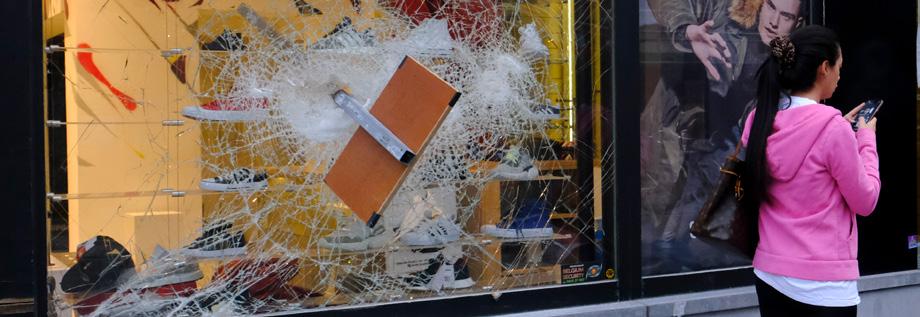
engaged in unlawful activities, according to the retailers convened by the LPRC. Some journalists noted that many looters appeared to be methodically blocking off certain streets with their vehicles, working cooperatively, and calling out commands to one another, while others seemed to spontaneously join in.
That protests associated with the killing of George Floyd were co-opted by many people for many reasons seems to suggest the threat has grown and that protests could more likely spark violence in the months or years ahead. If Occupy Wall Street protests erupted today, would they be as peaceful?
Tony Gallo, a longtime LP executive and managing Tony Gallo partner at Sapphire Risk Advisory Group, a retail security consulting company, said he saw significant levels of organization in some attacks on clients, which are primarily high-risk specialty businesses such as jewelry stores, cannabis dispensaries, and pawn shops. “I think we saw more organized groups [in this summer’s looting],” he said. “In one case, a gang actually secured a store for several hours, fending off other looters, while they proceeded to attack the store safe.”
Sergeant Ray Kelly of the Alameda County (California) Sheriff’s Office described an attack on a local car dealership—during which seventy-five vehicles were stolen while police were occupied at protests in Oakland—as being “very strategic” and carried out by “well-coordinated criminals.” Los Angeles Sheriff Alex Villanueva said his department intervened in a significant coordinated operation “to sack an outlet mall.” Neil Sullivan, an expert on mass events security and retired commander for the city of Chicago, thinks it marks a new day. “I have been a student of these things,” he said in an AP interview. “And I have never seen anything like it.”
Industry experts like Caroline Kochman, executive director at the National Association for Shoplifting Prevention (NASP), could probably see it coming. She told LP Magazine that her group tracked an increase in retail theft activity following two recent galvanizing events, the 9/ 11 terrorist attack and the 2008 financial crisis, and that it loomed as stores reopened after the COVID-19 pandemic lockdown lifted. During an
LP Magazine webinar, John Matas, CFE, CFCI, cochair of the International Association of Financial Crimes Investigators, said he was expecting the same. “When the brick-and-mortar stores start to reopen, there’s no doubt that there is an anticipation of significant theft issues.”
Large-scale peaceful protests, then, provided perfect cover to those already itching for a chance to strike. And the impression that looters largely got away with their activities this summer could raise the risk that any future protests—for any number of causes—will be used by organized gangs to commit theft.
During the LPRC emergency call, retailers noted that police in some cities were overwhelmed. This risk may also be exacerbated as some cities are heeding calls to shift monies away from police toward social services for communities of color. While it may or may not be a better allocation of funds for those communities, it could certainly leave police departments less capable to respond when cities catch fire. Los Angeles Mayor Eric Garcetti, with protests still ongoing, announced he was slashing the LAPD’s budget by more than $150 million. As local communities undertake efforts to reshape the role of police, retailers and their security representatives should get involved so that the industry’s interests and expertise are included in the conversations.
A Need for Intelligence and Analysis
The gathering speed at which viral videos travel is impressive, and yet there is typically a lag between events hitting online and when they catch fire. George Floyd’s killing, for example, started trending on the homepages of websites like Yahoo some thirty-six hours before commercial property damage in Minneapolis and several days before criminals were using the cover of protests in other cities to loot retail stores. It is a compressed timeline to be sure—from video, to outrage, to organized protests, to protest spiraling out of control and stores being damaged—but long enough for retailers to issue emergency alerts, enact contingency plans, and take critical actions to harden properties and remove and protect valuables.
Knowing about a fraught event in real time can provide LP teams with a valuable lead. Social media provides a critical temperature check, but even before the comments section beneath the video to George Floyd’s killing started to fill, experienced security leaders, if aware of the breaking story, would know that store assets were at risk. Advanced intelligence is key. An early-warning system can be a lifeline to stores at risk.
Some LP teams at major big box stores work on the principle that any event that impacts communities
Inventory Quarantine
Safely process returns in Real-Time
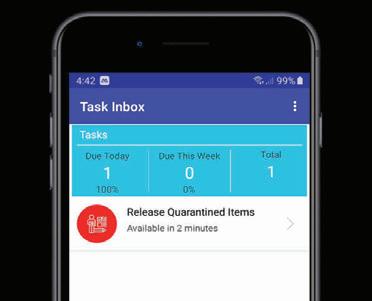

checkpointsystems.com/us/Inventory_Quarantine/

impacts their stores. If so, then LP needs to know about every incident that a community will feel. Crisis teams have grown accustomed to tracking weather events, but what about events that threaten to inflame or incite? “Just like with an approaching hurricane, there is always some time where you can see what’s coming. Even if it’s just that a protest is scheduled for tonight, it gives you warning to take critical actions,” said Gallo. It can be lifesaving intelligence that corporate teams can then use to reduce the risk of harm to staff, by warning store managers to be vigilant, ramp-up security or staffing, or close stores.
That, then, seems a critical point of review: how does a retail security team learn and make sense of incidents that could spark unrest? Is the process sufficiently robust to immediately learn what’s happened, to anticipate what’s going to happen next, and to put it into context, assign risk levels, and facilitate a response?
As noted earlier, the motives for violence were muddy and players diverse, which made the threat of violence and looting vary city by city and night by night, according to the Department of Justice. Local officials’ decisions to enact curfews—or not—varied wildly. Police response also differed, and in some cases “delaying a show of force may have exacerbated unlawful activities,” according to the LPRC summary of member input. All such information needs to be gathered, contextualized, compared against asset locations, and then acted upon.
And it all must happen on the fly,
said retailers participating in the
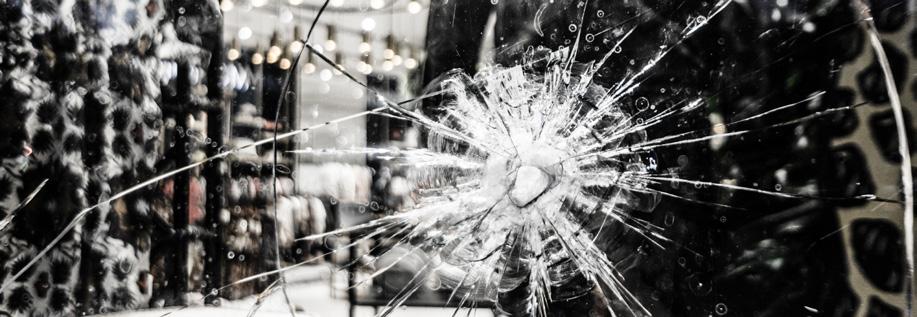
emergency meeting convened by the LPRC. They noted that situations across the country were constantly and rapidly evolving and that there was considerable variation in unrest across cities and states. It was “a new situation every day, sometimes every hour,” making it “important to continuously track activities and threats.” Tony Gallo noted that his clients were affected first in Minneapolis but that the biggest problem he saw was in California. “It can start in one place and then all of a sudden shift to another part of the country, and then somewhere else,” he told LP Magazine. While not every rioting event tracks the same, the advice from LP executives on the LPRC emergency call on the topic of intelligence-gathering
Marcio Gianotto / Shutterstock.com and information management is probably a good roadmap for whenever social unrest starts to swell: ■ Connect with local, state, and federal law enforcement. “Protecting the business during a riot is dependent on effective local political and law enforcement engagement, to intervene to protect employees, customers, and the business,” noted
Pinkerton’s Timothy Williams. ■ Share intelligence with other retailers and law enforcement. ■ Use social media to track activities of organizations known to be involved in protests. Even if the organizations are lawful and peaceable, others may use the protest as an opportunity for crime.
The LPRC group suggested that major retailers should use a special investigations team to collect information on social media. ■ Follow information released by state and national retail organizations and others. ■ Benchmark with other local retailers regarding store hours and other practices. “Establishing good communications and relationships with other firms in the immediate area creates a form of mutual
‘guardianship’ of businesses in the area who could alert each other when disruptive crowds or demonstrations are forming or when an incident occurs in the immediate area that could result in problems,” noted Williams. ■ Collect on-the-ground information and provide information to your security operations center to be used on the ground. ■ Follow retail and other informative organizations. And be prepared to provide facts-based context for senior leaders who will be getting information from general media sources that could provide an unrealistic picture of risk, one LP executive suggested to
LP Magazine. ■ Assess risk daily. Periods of unrest are likely to have a peak and decline in activity.
Definitions of Types of Social Unrest
Level 1: Social Unrest
Peaceful protest
Level 2: Civil Disorder
Unarmed mob violence
Level 3: Mob Rule
Unarmed mob violence with no law enforcement
Level 4: Rebellion
Armed organized insurrection
LEVEL DESCRIPTION
Demonstrations, sit-ins, nonviolent protests Crosses boundary of illegality: riots, looting, arson
Systematic destruction aimed at targets of hatred Civil war, sectarian violence
EXAMPLES
DRIVERS
CHARACTERISTICS
DESTRUCTIVENESS
Peaceful anticapitalist protests, Occupy Wall Street campaign, US (2012)
Infringement of civil rights, government policies, economic conditions, unfairness London Riots (2011), Bombay Riots (1992-3), Bread Riots France (1788)
Economic disparity, unemployment, food price hikes, austerity driven cuts
Generally peaceful and isolated in character High potential for contagion and for damage
Disruptive to activities, no physical damage Property directly targeted, cars damaged, arson Paris Riots (2005), Rodney King Riots (1992)
Racial/ethnic tensions, religious tensions, lack of food or water
Law enforcement forced to withdraw, temporary
Systematic looting and destruction, specific groups being targeted, death and injury
Arab Spring, including civil war in Libya & Syria; French Revolution (1789)
Sectarian violence, elite factionalism, wide-scale unrest
Often protracted conflict with the potential to spark regional conflagration
Large scale physical and infrastructure damage, high death toll, massacres
Source: G. Bowman, F. Caccioli, A. W. Coburn, R. Hartley, S. Kelly, D. Ralph, S. J. Ruffle, J. Wallace. 2014. Stress Test Scenario: Millennial Uprising Social Unrest Scenario. Cambridge Risk Framework series, Center for Risk Studies, University of Cambridge.
■ Use intelligence and analysis to tailor messaging to teams in different locations. ■ Release reports to teams on daily basis if necessary.
Gathering information is vital, and intelligent analysis of information is also necessary. Mob violence is still facilitated by social media, but simply monitoring for mentions may no longer be sufficient as looters seem to have grown wiser at the social media tracking performed by law enforcement and businesses. For example, several retailers noted that offenders were at times targeting locations away from areas where protests were being planned and where they believed police would not be. New York Governor Andrew Cuomo said some people stealing from stores were using encrypted messaging to communicate. In the San Francisco area, there were false tweets about looting and rioting that police believe may have been attempts by thieves to divert the police away from targets they wanted to hit, including a false tweet about an officer being shot in one area while a cannabis dispensary was being looted elsewhere. Groups of thieves struck a series of big box stores on Chicago’s South Side while periodically calling 911 to falsely report that a mall several miles away was being ransacked, a city council member told the Associated Press.
For smaller retailers, like the high-risk specialty stores that Gallo works with, “constant contact with law enforcement is particularly critical to get advanced notice and take appropriate action.” Some larger retailers combine such coordination with social media monitoring tools or crisis management intelligence platforms, like tools offered by Dataminr, Everbridge, and Echosec. Location-based social intelligence software can be useful for monitoring protests, allowing users to define a specific geographic area—a mile-wide circle around a store near a protest site—and then live stream the geotagged location of all social media posts within the defined area that contain keywords of interest, the store’s name, for example.
At the 2019 NRF Protect conference, Ryan Mason, asset protection analyst at Big Lots, said they use a real-time information platform for more timely and informed
decisions during critical events and to and disrupting fencing operations, views on social issues have grown get a better sense of their scale. “We working with online marketplaces to more common, with some brands can have eyes on the ground during prevent the sale of stolen goods, and finding it a good way to connect the event through social media,” he promoting the ability to identify and deeply with their customers and draw said. The top LP executive for a luxury track goods at the product level and others in. Issues from transgender global retailer added that protest areas develop benefit-denial theft prevention bathrooms to open carry have had and activities are often publicized in solutions. As hard security measures their moments. Social media has made advance and that information were overwhelmed, all that remained it infinitely easier for the public to put monitoring helps alert them to an was the ability to deny looters pressure on retail organizations to take imminent escalation of tensions. opportunity to capitalize on their positions on socially and politically
By layering company policies and crimes. (For more on reducing rewards tinged issues. protocols on top of threat data, from committing crime during social Protests this summer against police perspective on the events as they unfold is critical for understanding intelligence and communications work brutality and systemic racism saw retail organizations weighing in more An ever-present threat, the risk from vandalism could than ever before. Many issued statements of solidarity with peaceful grow as stores and retail brands become surrogates for protestors. “The murder of George political expression and as racial tensions rise. There was Floyd has unleashed the pent-up pain of years, as have the killings of already a rise before the pandemic in property destruction Ahmaud Arbery and Breonna Taylor. characterized as hate crimes—more than a 10 percent We say their names and hold a too-long list of others in our hearts,” increase in 2018 over the level from three years prior. wrote Target CEO Brian Cornell. Some, like Gap, Target, and Lululemon, gave money to show support. Small retailers wrote messages of support on plywood covering store windows. While some retailers may Tverdokhlib / Shutterstock.com have faced blowback for perceived hollow hashtag activism, saying nothing at all risked intense criticism. From an LP and security perspective, corporate value statements raise the consequence of LP department software solutions can automate unrest, see the accompanying sidebar counter to the values that retailers execution of predefined for advice shared by the Loss promote to the public. For example, a communications processes and track Prevention Research Council.) retail brand may try to aggressively progress, which can be a critical lifeline promote itself as fighting for racial if social unrest is starting to roil. “The goal…is to achieve situational safety The Addition of Reputational Risks justice, but a lawsuit against it alleging discrimination in shoplifting stops or quickly, and with as little risk as Like popular pro athletes, retail surveillance, or a single recorded possible,” according to Mike Anderson, brands historically have maintained incident of mistreatment with racial chief operating officer at Echosec, a neutrality on hot-button societal issues. implications by store personnel, could dark web and social media threat Also like athletes, that has changed. quickly wipe out its effort to shape intelligence firm. “Getting a clear Public expressions by retailers of their that reputation. what’s actually happening. Social Property Destruction/Vandalism media monitoring allows rapid access Incidents, 2015 vs. 2018 to this information.” 2015 2018 Pct. Change
Finally, looting this summer Destruction/Damage/Vandalism, All Incidents 698,158 717,424 + 2.8% revealed value in the “everyday” Destruction/Damage/Vandalism, Hate Crimes 1,698 1,876 + 10.5% operations or incidents that run that LP teams do, including identifying Source: FBI data from Uniform Crime Reporting Program, National Incident-Based Reporting System
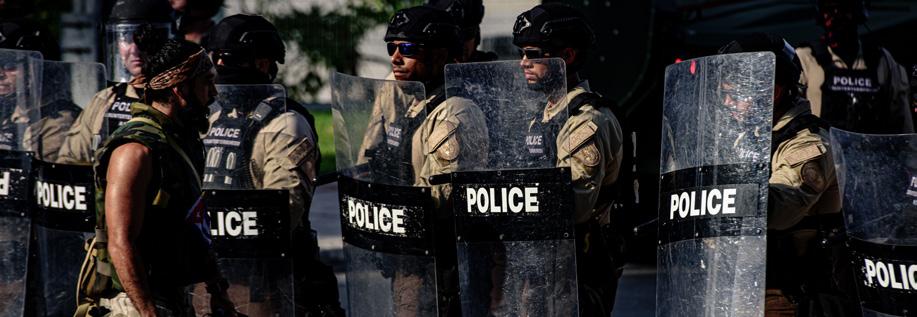
Given the growing potential for harm, retail LP departments might find value in reviewing their policies, staffing, training, and oversight to assess if they should do more to prevent the possibility that LP activities could expose a retailer to a claim of being hypocritical or cause lasting damage to its relationship with customers. On June 11, for example, Walgreens issued a statement that is was changing loss prevention tactics, a move that Walmart and CVS also made. “We are currently ensuring multicultural hair care and beauty products are not stored behind locked cases at any of our stores,” the company said.
A baseline for preventing a store incident with racial or ethnic overtones, which could put it in an unwelcome spotlight, is a strict nondiscrimination policy, periodic reminders to employees of acceptable and unacceptable behavior through emails and training, and swift discipline for any violations, according to Professor Sameer Hinduja, Department of Criminology and Criminal Justice, Florida Atlantic University. To better target training and awareness activities, LP might consider research that shows racial and ethnic tensions that contribute to violent incidents at businesses are rarely isolated from the surrounding community. Thus, an organization’s attempts to address them may benefit from some sort of community engagement. Studies show that—in terms of racial and ethnic hostilities—the relationship between the community and businesses is a reciprocal one.
Today’s divisive political and social climate creates security risks for retailers. The threat would grow if retailers were to receive even less public support for store safety. Police response to shoplifting and store crime was already on the decline across the country. Now, as cities such as Minneapolis discuss dismantling police departments in favor of unidentified “community-based safety” solutions, it is possible that retailers may soon be expected to bear an even greater burden for managing and investigating incidents that occur on store property.
Retail brands can also become the specific target of protesters. As noted, some actively court customers by being outspoken on social issues, and while this can strengthen loyalty among some consumers, it can anger others. And more groups than ever exist that are ready to call out what they see as a retail organization’s faults. “There has been an explosion in the creation of groups that cater to all ends of the social ideological spectrum—many of which focus upon a very narrow subject area or cause,” according to a report by Damballa, a network security firm. No issue today seems too trivial to attract at least a small group of people who are willing to actively engage in its support or opposition, and picking sides—or even appearing
They have a great shopping experience.
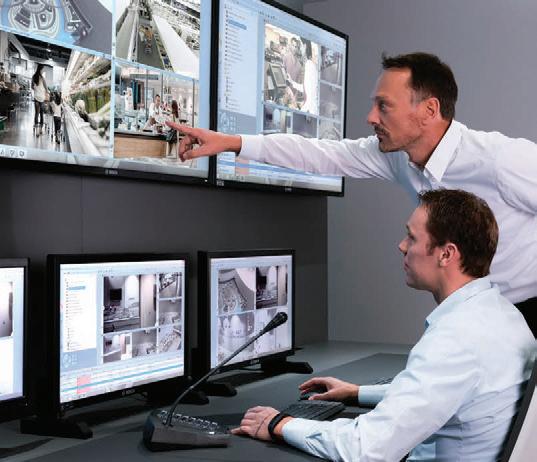
You have greater peace of mind with a solution that secures your profits and assets.

Bosch empowers you to build a safer and more secure world with solutions that enhance safety, reduce shrink, and help improve merchandising, operations, and service through valuable customer journey insights. Bosch integrated security and communications solutions enrich the customer experience and deliver valuable data to help you increase your profitability.
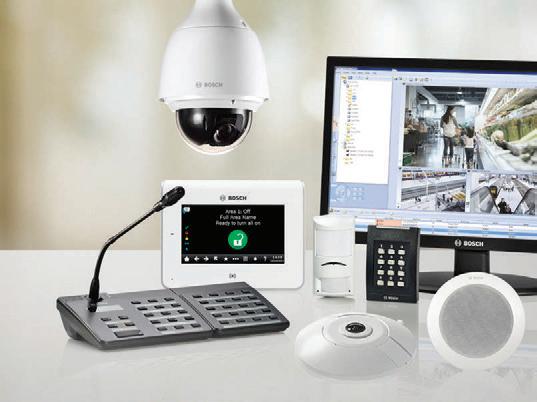
Learn more at http://bit.ly/BoschRetailSolutions
to pick sides—can make retailers more likely targets of protest groups. So in addition to generalized unrest, retailers themselves could become the more frequent targets of protesters in the months and years ahead.
Large retail companies have already been targeted for the alleged climate crime of “fast fashion,” for example, and social media has the ability to quickly generate enthusiasm for a cause, stoke anger, and organize and mobilize protests among striking workers or picketing consumers. Monitoring what is being said about a retailer on blogs and in social networks will help identify if a retail organization may become the target of activists and protests, and investigating how adversaries operate will suggest the risk they pose. Ultimately, how retailers manage those protests or strikes from a security perspective may directly affect the amount of reputational harm they do.
In a highly charged environment, retailers can also find their affiliations troublesome, including those with law enforcement. Target, for example, has a long history of working cooperatively with the Minneapolis Police Department, including helping to improve the safety of downtown shopping areas through joint video-surveillance initiatives. While the outreach has been the subject of praise historically, it made the retailer a bigger target in the aftermath of brutality by Minneapolis police officers. Widely shared posts on social media recast those safety initiatives, such as one that read, “Did you know that in 2004 Target spent 300k on cameras in downtown #Minneapolis to help MPD terrorize black + brown community members? And that Target actively funds the lie that cops exist to ‘protect communities’?”
A retailer’s own associations aren’t the only input for risk assessment, of course. To understand risk to a store, an LP team must assess whether any vulnerability or issue may cause neighboring stores or businesses to be the target of protesters, a threat that could then spill over.
The General Services Administration’s Office of Federal Protective Services, for example, uses a highly detailed risk-management model that includes the target attractiveness of neighboring organizations to assess risk to federal buildings. For example, a store’s risk level increases if it is near, say, a reproductive health clinic, a biotechnology research company, or a government office, and key dates that are significant to individuals targeting those buildings may suggest “occasions” for risk that a store hasn’t considered.
Lessons in Store Protection
Crime data on property destruction shows retailers are a frequent target of vandals. The total number of attacks on
Applying Principles of Situational Crime Prevention to Reduce the Impact of Civil Disorder on Retail Operations

Reduce rewards of committing a crime.
■ Place high-value items, equipment, and merchandise in stock rooms under additional security (for example, install locking door bars). This increases effort required to steal valuables; furthermore, if the store seems empty, it may make some offenders believe the store has already been looted on a previous occasion. If possible, move these items to an offsite storage facility. Note: this may not be possible when roads are blocked or when there is not enough time to safely organize and move inventory and other valuable property. ■ Remove all personnel files containing sensitive information from store locations. These files can be used to steal employee’s identities, engage in all types of fraud, and can enable offenders to use the information to breach IT systems. Remove all window merchandise displays even if windows are boarded up. Once boards are breached, you want offenders to believe that it is not worth removing additional boards or breaking windows; if the first thing they see upon removing one board is attractive merchandise, they will remove more boards and break windows to get to the merchandise. Attach security tags and devices on products in places that will damage products if removed without proper tag removal tools. This will make these items less-desirable targets. Ensure that any store equipment is marked as belonging to your company as this will make it more difficult to resell and thus less desirable.
Source: Excerpt from Responding to Civil Disorder by Cory Lowe, MA, PhD Candidate, University of Florida, Loss Prevention Research Council, 2020
department, specialty, and convenience stores exceed the number on colleges, universities, and secondary and elementary schools. Additionally, the most recent law enforcement data shows vandalism has been growing. Incidents of property destruction in 2018 were up nearly 3 percent compared to 2015. The risk reaches its peak between midnight and 1:00 a.m., data shows.
For protection, looks matter, according to Bob Doyle, a security expert, thirty-seven-year law enforcement veteran, and former police officer with the Suffolk County (New York) Police Department. “Having a comprehensive plan and approach to security that includes guards, alarms, exterior lighting, and Bob Doyle cameras, along with physical security, makes a retail operation look more secure and protected,” he said. “A protected store becomes less of a target than one that does not go to these lengths,” as vandals and looters typically move to low-hanging fruit.
An ever-present threat, the risk from vandalism could grow as stores and retail brands become surrogates for political expression and as racial tensions rise. There was already a rise before the pandemic in property destruction characterized as hate crimes—more than a 10 percent increase in 2018 over the level from three years prior—and there is anecdotal evidence that the shutdown stoked racial tensions that especially crippled select retail establishments. It is certainly true that such incidents were well reported as news outlets eagerly reported on any fresh angle on the coronavirus crisis, but the volume of the reports were hard to disregard. Across the country, news accounts of
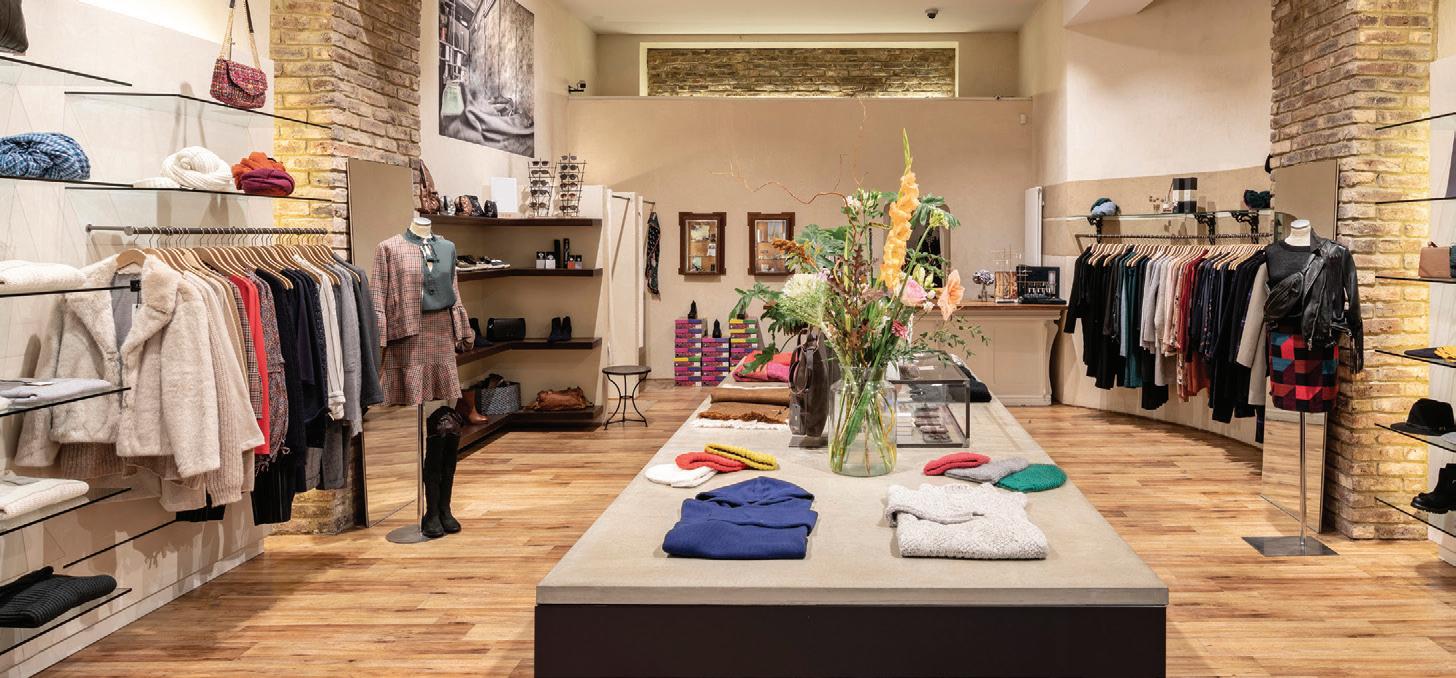
Asian-owned businesses being hit by vandals were especially common in April and May.
Measures to protect stores against routine vandalism are helpful against social unrest. Some stores were spared this summer because of hardened exteriors. But even those measures were overwhelmed, as many videos showed groups tearing down metal security gates to get inside stores. Retailers sharing their experience in the LPRC emergency call in June said boarding up windows and bars on doors was recommended for hardening exteriors, while acknowledging may only delay entry. Other ideas they offered to protect against looting and arson included using water barrels, since they can act as an inflammable, heavy obstacle; reducing opportunities for crime by removing make-shift projectiles and combustibles or flammables; and when possible, placing high-value items in safes, secure storage, or moving them to a more secure
location. “As we saw with rioting and looting, some stores were burned. This makes it even more important to have an effective fire alarm and fire suppression system,” Doyle told LP Magazine.
He also believes retailers need to think more about attacks during social unrest as they consider store design. “Architectural design will need to change,” he said. “Retail shops and stores of all kinds will have to review their design and how products are displayed. Window display areas may need to be separated from stores by walls so that if a window is broken, access to the entire store is limited.” Especially in densely populated urban areas, where disturbances are most likely, he sees a greater role for roll-down metal gates, steel reinforced doors, and bullet-resistant or hurricane-resistant glass coatings to slow down access to store interiors.
Pinkerton’s Timothy Williams thinks the extraordinary events surrounding the protests this summer could cause some retailers to consider investing in more substantial barriers to deter rioters, but says state-of-the-art crime data and projections are important to “determine the proper calculus for each location based on risk” and to balance security costs against buying more insurance.
On the subject of safes, Gallo said he knew of more than 200 break-ins, and while gun and fire safes were penetrated, he did not know of a single case in which looters were able to defeat a TL-rated safe. “You want to board up if you can, take home any personal items of meaning to you, and I’ve been
preaching [to high-risk specialty store
Halfpoint / Shutterstock.com
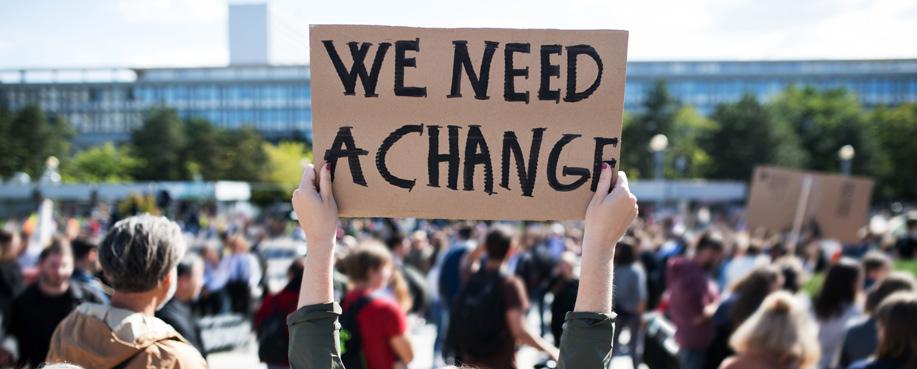
clients] to pack your TL-rated safe or vault with everything you possibly can and to use that as your lifeboat. Looters just don’t have the experience to get into those safes.”
Gallo said he also saw some stores forgetting about the risk to data and intellectual property during the unrest. “A lot of stores were not backing up their data and customer files, so when the store was breached and looters stole everything, including hard drives, they lost all their files.” LPRC members similarly noted the importance of removing personnel files from store locations at risk of looting.
“An intellectual property security plan needs to be part of an emergency plan,” advised Gallo, noting that it is one of many planning elements that multistore retailers need to take, including assigning risk ratings for store locations. “I think failures go back to an it-will-never-happen-to-me mentality. As a business owner, you must be more proactive, and it’s a lot less expensive than being reactive.” He says he sees it as a “huge deficiency” in how retailers prepare for protests and the risk from social unrest. “You don’t go to Home Depot and buy plywood on the day the hurricane arrives,” he said by way of example.
Williams offered similar advice to retailers. “Protecting the business during a riot is dependent on appropriate preplanning. Crisis management preparations for retail must always take into consideration riots and civil unrest as a critical aspect of their planning,” he said. “Incidents like what we just witnessed across the US remind us that the most accessible and vulnerable businesses are in the retail sector. Constant vigilance, communications, and preplanning are critical to protect retail businesses in a riot.”
One vital aspect of planning, say experts, is to consolidate policies on managing demonstrations and civil disobedience. Having policies spread out among departments, and in different locations within each department’s policy manuals, can create confusion during an actual event, they warn. One LP director noted the importance of maintaining a comprehensive list of actions that may be necessary to take to help a store location prepare for a protest or unrest, which is not something that can be pieced together at the last minute, he said.
Preplanning for protests and potential social unrest allows stores to more quickly secure critical property and close stores, thus reducing the risk of harm to store personnel—the top priority noted by LPRC members. “I’ve seen people staying in stores, and I am very much opposed to that,” said Gallo, citing one pawnbroker who remained in his store during the looting this summer and was shot and killed.
Williams agreed. He said it’s critical for retail organizations to instruct—and
make sure employees understand—that their safety is paramount, and that they should never try to physically defend the business during looting events. “Merchandise can always be replaced; they cannot.”
As such, evacuation must be part of LP’s preplanning. “Plans must be in place and employees properly trained as to the steps to take if a riot occurs when the business is operating,” he advised. “Evacuation routes need to be predetermined and the circumstances made clear for when locking the store and holding in place may be a safer alternative. Safe evacuation may be the only alternative when rioters are overwhelming businesses.”
As social unrest started to spread this summer, Williams said some retailers began considering use of armed security personnel, but he warned retail security pros to think critically before making such a decision and suggested asking the following questions: Is the use of the armed personnel to ensure the safety of employees, merchandise, or both? Is it reasonable to think that such steps would even be effective in a riot or severe demonstration? Are you prepared to deal with the ramifications of using deadly force to protect the business? Could such force simply further target the business for greater harm during a riot?
Looters are brazen, certainly, but they are not immune to security measures, and even rioters act “rationally” in a way, according to academic research, including “Anatomy of Riots: A Situational Crime Prevention Approach,” a study published in Crime Prevention and Community Safety (July 2007). “Even though a mob behaves irrationally and indulges in senseless acts of violence and destruction, the individuals comprising the mob are rational and guided by self-interest in their behavior,” according to the study. “Therefore, even in riotous situations, rational choice perspective can be profitably exploited to prevent mayhem.”
LP pros participating in the LPRC emergency call noted that traditional situational crime prevention techniques are applicable to protecting stores during times of social unrest. “Videoing and photographing looting deter offenders,” they noted, and recommended identifying perpetrators using surveillance video, license plates, and other means, and to save as much information as possible to file reports when protests ended. Police departments, many criticized for a lax initial response to looting and property destruction, promised to use footage to retroactively target criminals.
“Advanced technology can play a role as an intimidator,” said Maurizio Pejoves, director of P&O Global Technologies, noting that high-resolution Maurizio Pejoves images have amplified the ability of video to fill that role. One LP executive noted that IP cameras played an important role in giving his team a live look at unfolding situations at stores they were forced to close.
Bob Doyle suggested that available technology solutions to discourage looting are going unused in the retail industry. He sees room for greater adoption of video alarm verification; sensors and cameras that detect when glass breaks, instantly send an alarm, and start recording high-definition video; and internal and external flashing lights and sirens that provide an audible deterrent. “There are even systems that fill rooms with clouds of harmless fog, which makes it hard for a person to see or move around easily in a retail store that is being looted or vandalized. Fog and sounds disorient and help to repel looters and vandals,” Doyle said.
The risk from vandals should be— but often isn’t—a consideration when purchasing store cameras, Pejoves said. Retailers should consider vandal-proof security cameras for any reachable areas, and cameras should have a battery backup and surge protection, he said. Sharing permissions in advance of protests so that law enforcement can view camera feeds and watch for suspicious activity can add another layer of protection. “It is also essential to have the main security system in a secure area,” he added. “I always recommend hiding the system out of sight, whether it’s in the attic or ceiling, so in case there is a violent or looting event, the system would not be able to be destroyed.” There are also temporary technology solutions that can support a retailer if there is a risk for protests to spark unrest, Pejoves noted. Adding spotlights around the perimeter can help, and “there also are temporary mobile stations that work with solar panels, that allow you to temporarily install a trailer on the perimeter or in the parking lot. You can remove when necessary and won’t have to run cables through your property,” he said.
From interviews with LP pros, here are additional preparations suggested for protests: ■ Complete crisis preparation forms in advance of scheduled events to help guide risk assessment and mitigation.
This can include information such as the asset’s proximity to the event; store construction, such as its number and placement of windows; store hours; neighborhood characteristics; and previous store crime. ■ Assess how practical it will be to operate normally during the protest and plan for employee absences in the event protests disrupt local transportation. ■ Prepare to execute contingencies in the event armored cars are unable to make cash pickups. ■ Create a specific alert or alarm to notify store personnel to a multiple-offender event. ■ As far out as possible from an identified event that could potentially spark public disruption, disseminate relevant information to store managers.
GARETT SEIVOLD is senior writer for LP Magazine. A trained journalist, he has spent the majority of his career writing about security, risk management, supply chain, and loss prevention topics. He can be reached at GarettS@LPportal.com.







